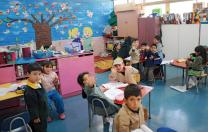Recruiting Jack Shonkoff in 2006 was the key to creating the new Center on the Developing Child (CDC), says University provost Steven Hyman. In Shonkoff, Harvard has “a person of enormous energy, with precisely the right temperament for interdisciplinary research and education: relentlessly curious, respectful of diverse disciplines, and a very talented convener of people from diverse communities.”
Shonkoff, a pediatrician, had served at Brandeis as dean of the Heller School for Social Policy and Management and chaired the committee that wrote From Neurons to Neighborhoods, an exhaustive 2000 report from the Institute of Medicine on child-development science and policy. But to reach a wider audience, he realized he would need to highlight themes in ways that resonated with the public.

Drs. Ana Magarinos and Bruce McEwen, Rockefeller University
The brains of rats subjected to chronic stress (left) show less branching (fewer and shorter branches) on neurons in the hippocampus, in a key brain region for processing incoming information for learning and memory, when compared to rats that were housed in normal laboratory conditions (right).
To investigate prevailing attitudes about child development and frame messages in response to those attitudes, he engaged a communications-research firm. For example: persistent stress can disrupt brain circuits, causing decreased branching of neurons in the hippocampus and prefrontal cortex (the brain areas associated with memory and higher-order thinking, respectively), and increased branching in the amygdala (the seat of emotion, and fear in particular). Such explanations fascinate listeners with a scientific bent—but may make others’ eyes glaze over. So Shonkoff, in speaking to lay audiences, now uses models that are simple and vivid, but still accurate. His “brain architecture” model conveys the idea that early adversity can lay a shaky foundation for later development.
In response to the popular notion that stress is character-building, Shonkoff uses a three-tiered model. “Positive stress” does exist: “This is the stress of the first day at a preschool program….This is the stress of having to go down for a nap when you’d rather stay up and see everything else that’s going on….It is a necessary part of healthy development.” One level up is “tolerable stress”—unhappy experiences that nevertheless don’t disrupt brain architecture because the stress is “buffered by supportive relationships,” helping stress hormones, heart rate, and other biological measures of stimulation return to baseline levels. “Toxic stress,” on the other hand, is “literally poisonous to brain architecture,” in ways scientists affiliated with the center have demonstrated and are continuing to explore.
By the time Harvard recruited Shonkoff, he had already begun taking this carefully crafted message about the impact of early-childhood experiences to state legislatures. His testimony has led to passage of legislation in Nebraska (which nearly doubled state funding for early-childhood programs for children of low-income parents), in Washington state (which established a cabinet-level department of early learning), and in Kansas (which passed a comprehensive bill with education, childcare, and health-insurance components).
He describes his earlier engagement in partisan advocacy, driven by ideological rhetoric, as “an exercise in futility.” He now practices what he says is a more effective approach: “Teach, don’t preach”—stick to the science and let the lawmakers work out the details of policies that are grounded in sound science and acceptable to colleagues and constituents. The center is hoping this approach will bear more fruit soon: it brought delegations from 14 state governments to Harvard last June, and is providing support as these states try to rewrite their own policies to better serve children.
The CDC has become a forum to showcase other places where good things are happening. It considers communications a central part of its mission: summarizing recent studies in nontechnical language and publishing roundups of research so practitioners and policymakers can have current findings at their fingertips. The CDC is also devising an international agenda that it will pursue in collaboration with the Harvard Initiative for Global Health, where Shonkoff chairs a working group on children.
On campus, the center began raising awareness last year with a colloquium series highlighting the relevance of child development for Harvard’s various faculties: education, public health, government, law, business, and medicine. Shonkoff himself teaches a course, “The Science of Learning, Behavior, and Health: Implications for Early Childhood Policy,” jointly in the schools of education and public health; medical students, and now undergraduates and Kennedy School students, may enroll, too.
Among undergraduates in particular, there is a hunger to get involved with these issues, says Ho Tuan ’09. After consulting with Ho and other undergraduates, Shonkoff and CDC deputy director Gillian Najarian, Ed.M. ’93, have begun to envision a secondary field in child development and a list of professors who work on child development and are willing to have undergraduate research assistants in their labs. The college years, they say, are a critical time to reach students—before they have decided to specialize in science or policy, while their minds are still open to the idea that one could do both.
In finding faculty colleagues, Shonkoff has sought out people with enthusiasm for the hybrid approach that distinguishes the center and positions it for maximum impact. “Not everybody at Harvard is a collaborator,” he says. “It takes a certain kind of intellectual flexibility and a sense of adventure to work across disciplines. Our goal is not simply to have people from one discipline tell people from another discipline what they’re working on….It’s less about sharing and more about creating together.”








